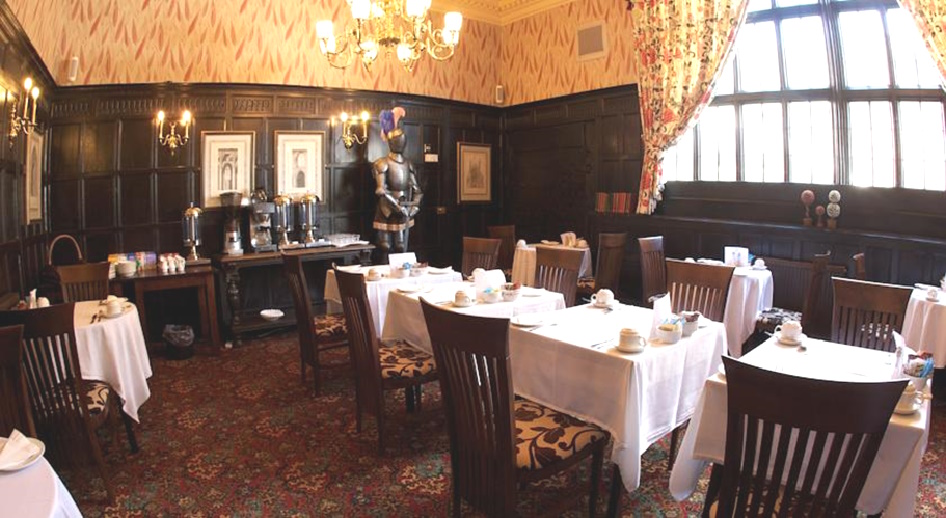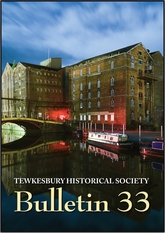Changing Rooms & Fashions
[Emma Shakesheff]Click Image
to Expand
This year I was fortunate enough to be shown some of the surviving painted murals in The Royal Hop Pole Inn in Church Street, which comprises three historic buildings dating from 1500-1800.[1] Preliminary research suggests the paintings may date from the sixteenth century as they have classical designs with a dark grey or black background.[2] The surviving murals consist of a repeating pattern in one bedroom and two large elaborate pictures. Peter Thornton argues that “figurative painting was in fact executed only in quite exceptionally important rooms”.[3] The location of the inn on one of Tewkesbury’s main streets and the large medieval hall illustrates that The Royal Hop Pole had always been a high-status building. The impressive murals led me to question how interior wall decorations changed over time through the early modern period in Tewkesbury.
The inn would have been better furnished and decorated than humbler properties. This was due to a different aesthetic being at work than in modern times amongst the lower ranks; beauty lay in having the necessities of life close at hand.[4] Properties like The Royal Hop Pole dated back to a time when the town was still strongly connected to the local Gloucestershire gentry.[5] Originally the premises may have been part of a high-status private house as the innholders can only be traced back as far as 1774.[6] However, some other high-status buildings had painted interior decoration; for example, the Bell Hotel in Church Street reconstructed in 1696 features a seventeenth-century wall painting in the dining room.[7] Fragments of murals and patterns also survive from elsewhere; evidence from Shropshire suggests that members of the lesser gentry and the middle ranks also decorated their homes in a similar manner. This practice fell out of fashion and became uncommon by the middle of the eighteenth century.[8]
Nationally, building design and ornamentation became less vernacular over time due to changing tastes. The traditional half-timbered appearance of buildings fell out of fashion to be replaced by the straight stone or brick lines of neo-classical architecture. The adoption of a European style of architecture based on ancient Greek and Roman designs was seen as the outward manifestation of politeness and enlightenment. Norah Day argues that in 1698 many townspeople were having the fronts of their properties “refurbished” to make them appear more modern. It is possible that similar revamping may have been going on inside to update interiors.[9] Grand and high-status properties were frequently decorated with moulded plaster in repeating patterns, for example egg and dart motifs or rococo swags and swirls. The displaying of pictures and prints appeared to be the most popular method of decorating the walls of middle-ranking homes. Lorna Weatherill argues to the contrary that contemporary paintings and engravings show that many eighteenth-century people lived simple lives with few possessions, and “that ornamentation was rare”.[10] It is clear that the majority of Tewkesbury residents, whose inventories survive, generally had a lower standard of living than the people in Hereford and Ludlow.[11] The constant threat of flooding may also have contributed to householders not decorating their interior walls.
A more expensive and high-status method of covering bare walls was to install wooden panelling; this could be made from a number of different woods. The cheaper pine and other softwood panelling were normally painted.[12] It was believed that imported oak from northern Europe known as wainscot made the best type of panelling.[13] This type of panelling would have possessed its own decorative appeal as Maurice Howard[14] argues that “from the late sixteenth century inlaid woods were more often employed and the arrangement of panelling became grander”. Wainscot was the “most refined way of covering a wall”; the use of such panelling became widespread in better houses from the sixteenth century and it was not always regarded as a fixture.[15] Wainscot panelling was expensive and was removed from obsolete buildings to be re-used. In Tewkesbury, Elizabethan panelled rooms can be seen in the Cross House in Church Street and the Tudor House Hotel in the High Street preserves its late seventeenth-century Court Room.[16]

A cheaper form of wall decoration that was available in many different grades was wallpaper. This was available from the end of the seventeenth century, and wallpaper imitated expensive textiles, for example velvets, damask, silks, printed cottons and chintzes.[17] This gave rooms a comfortable and fashionable appearance. There is little evidence, however, to illustrate its use from Tewkesbury probate documents.[18] This does not mean that wallpapers were not used, only that it was not in the assessor’s interest to chronicle its existence. Two documents from Hereford imply its use. An inventory of an apothecary’s shop records a parcel of old books that the assessor thought were “fitt for only wallpaper”.[19] Also the will of Susanna Poole records “my will is that my executor shall not after my decease remove any of the paper or hangings put up or fixed by me where I now live”.[20] Thornton argues that wallpaper was not common until the 1730s and it was found in large elegant rooms.[21]
The assessors of probate inventories mainly referred to rooms by their use or location, but occasionally they recorded the colour the room had been painted. In the late seventeenth and early eighteenth centuries, green seemed to be a popular colour for bedchambers, sometimes other colours such as red or yellow were used. There is not enough evidence from probate documents to suggest that particular colours were used at specific time periods. But a 1696 inventory from a saddler provides an insight into the colours that some households used. Richard Cooke owned a “whit [white] chamber, a red chamber, a blue chamber and a greene chamber”.[22]
This article has shown how wall decorations changed during the early modern period in Tewkesbury. The high-status murals in The Royal Hop Pole were subject to the same pressures of fashion as occurred in later periods. They were painted over when the desire for lighter and brighter interiors came into vogue. For the majority of Tewkesbury residents the most basic form of wall decoration was painting; like wooden panelling and wallpapering this allowed decorative objects like pictures and mirrors to be nailed on the walls. Only the wealthiest individuals, however, could have afforded wainscot panelling. As illustrated in THS Bulletin 18, there were luxurious and fashionably decorated premises in Tewkesbury that displayed large numbers of pictures and looking glasses, but these were a minority.[23] The movable decorative items were less likely to remain in situ over time. Tewkesbury in the early modern period had many large exceptional inns and residences that were able to afford the best types of interior wall decoration. These luxurious properties were the opposite of how the majority of the town’s inhabitants lived in small houses or down the many alleys, where interior wall decora tion did not appear a priority.
References
- Although sceptical when the purchase of The Royal Hop Pole by J.D. Wetherspoon was announced, we can only be delighted that the company has restored the public house beyond the call of duty when its medieval interior was discovered. The Hotel Manager, Emma Shakesheff, hosted a visit by members of the Society on 25 April 2013, when we were guided by restoration architect, Nick Joyce.
- Madge Moran, Vernacular Buildings of Shropshire (Logaston: Logaston Press, 2003) pp 326-8.
- Michael Snodin, ‘Who Led Taste, Tudor and Stuart Britain, 1500-1714,’ in Michael Snodin and John Styles, Design and the Decorative Arts (London: V and A Publications, 2001) p 66.
- Ian Mortimer, The Time Traveller’s Guide to Medieval England (London: Vintage, 2008) pp 29-30.
- Karen Banks, ‘The Cat with the Cream? Gentility through Possessions in 17th Century Tewkesbury’, THS Bulletin 20 (2011) p 41.
- https://www.gloucestershirepubs.co.uk/pubs/royal-hop-pole-hotel-church-street-tewkesbury/
- Malcolm Foster, A Walk Round Tewkesbury (Gloucester: Stoate and Bishop, 1971) p 7.
- Moran, Vernacular Buildings, p 340.
- Norah Day, They Used to Live in Tewkesbury (Stroud: Sutton, 1991) pp 53-4.
- Lorna Weatherill, Consumer Behaviour and Material Culture in Britain, 1660-1760 (Routledge, 1996) p 7.
- Karen Banks, ‘The Ownership of Goods and Cultures of Consumption in Ludlow, Hereford and Tewkesbury’, THS Bulletin 24 (2015) .
- Peter Thornton, Authentic Décor, The Domestic Interior 1620-1920 (Weidenfeld and Nicolson, 1993) p 21.
- John S. Moore, The Goods and Chattels of our Forefathers (London and Chichester: Phillimore, 1976) p 336.
- Maurice Howard, ‘Fashionable Living, Tudor and Stuart Britain, 1500-1714’, in Snodin and Styles, p 103.
- N.J.G. Pounds, The Culture of the English People (Cambridge, Cambridge University Press: 1994) p 153.
- Foster, p 17; Charles Hilton, A Short History of the Mythe, Tewkesbury (Lackland Books, 1985) p 60.
- Howard in Snodin and Styles (2001), p 105; Thornton (1993), p 99.
- Bill Rennison and Cameron Talbot, ed, Tewkesbury Wills and Inventories, 1601-1700 (Tewkesbury: THS, 1996).
- Inventory of AA20 William Wadele (1723), a Hereford apothecary.
- Will of AA20 Susanna Poole (1733), a Hereford widow.
- Thornton, p 98-9.
- F.C. Morgan, ‘Inventories of a Saddler’s Shop in the Years 1692 and 1696’, Transactions of the Woolhope Society (1945) p 253, 267.
- Karen Banks, ‘A Serving of Metropolitan Culture in Eighteenth-Century Tewkesbury’, THS Bulletin 18 (2009), pp 9-12


![The Medieval Wallpaper<br>[Emma Shakesheff]](/images/THS03645.jpg)
Comments